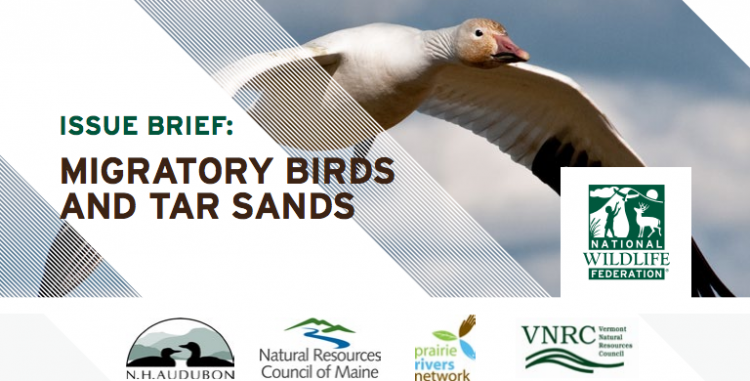

Report: Interior Must Address Bird Deaths Caused by Canada’s Tar Sands
Conservation Groups Urge Interior to Declare Canada is Undermining Wildlife Protections
cross posted from National Wildlife Federation
06-11-2014 // Miles Grant
Destructive mining and drilling practices in the heart of Canada’s forest bird nurseries have already killed thousands of birds and are putting millions more at risk, including the critically endangered whooping crane, America’s tallest bird. That’s according to an issue brief released today by the National Wildlife Federation and state affiliates Prairie Rivers Network (Illinois), Natural Resources Council of Maine, New Hampshire Audubon and Vermont Natural Resources Council.
(Full report embedded below)
The Department of Interior is under a legal obligation – known as the Pelly Amendment – to determine whether tar sands mining and drilling in Canada is undermining a century-old international treaty to protect North America’s shared songbirds and waterfowl. Tar sands are one of the world’s dirtiest energy sources. Not only do they have significantly higher life-cycle emissions of climate-disrupting carbon pollution than conventional oil, but tar sands mining is destroying bird habitat and leaving behind massive tailings ponds.
“Many of the birds Americans watch, enjoy and hunt fly to and rely on this area, but unchecked tar sands development is turning a thriving bird breeding ground into a toxic wasteland,” said Jim Murphy, senior counsel at the National Wildlife Federation. “The Canadian government, once our friendly neighbors to the north, vowed to protect these birds in the past. But today’s Canadian leaders prioritize polluting industries over conservation and are now fouling their own nest by going all-in on destructive tar sands drilling.”
As the report details, tar sands developments sits in the heart of the previously pristine boreal forest, an evergreen haven for bird production. But now an area the size of Florida is being destroyed by huge open-pit mines, toxic waste tailings ponds that can be seen from space, extraction wells, noisy compressor stations, refineries, and networks of new roads, drilling pads, seismic lines, and pipelines.
Oil-laden tailings ponds have resulted in the deaths of countless waterfowl:
- In 2008, 1,600 ducks died in Syncrude tailings ponds.
- An October 2010 storm resulted in hundreds of ducks landing on a Suncor tailings pond near Fort McMurray; at least 550 birds were too oiled to save.
- As of 2010, 43 species of internationally protected birds had suffered fatalities from exposure to tar sands tailings ponds. Unabated tar sands development could result in the reduction of 70 million hatchlings over a forty year period.
Of the 130 internationally protected American migratory and songbird species listed in the report as threatened by tar sands development, many are familiar names to bird watchers, hunters and wildlife enthusiasts in the United States, including: Snow Goose, American Goldfinch, Evening Grosbeak, Great Blue Heron, Common Loon, Northern Pintail, Wood Duck, Siskin, Trumpeter Swan, Cedar Waxwing, and the Pileated Woodpecker.
“Wildlife and tar sands don’t mix,” said Murphy. “The Canadian Government is putting polluting fossil fuel interests above the interests of birds and other species. Interior Secretary Sally Jewell and President Obama can send a message to Canada that it is unacceptable to undermine our shared wildlife heritage. The President needs to act by rejecting the pipeline projects, like Keystone XL, the tar sands industry needs and demonstrating that clean wildlife-friendly energy, not tar sands, is the answer.”
National Wildlife Federation: Tarsands Threaten Migratory Birds



